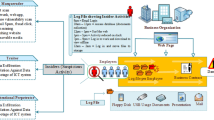Abstract
Insider threat detection is a major challenge for security in organizations. They are the employees/users of an organization, posing threat to it by performing any malicious activity. Existing methods to detect insider threats are based on psycho-physiological factors, statistical analysis, machine learning and deep learning methods. They are based on predefined rules or stored signatures and fail to detect new or unknown attacks. To overcome some of the limitations of the existing methods, we propose behaviour based insider threat detection method. The behaviour is characterized by user activity (such as logon-logoff, device connect-disconnect, file-access, http-url-requests, email activity). Isometric Feature Mapping (ISOMAP) is used for feature extraction and Emperor Penguin Algorithm is used for optimal feature selection. The features include time based features (time at which a particular activity is performed) and frequency based features (number of times a particular activity is performed). Finally, a Multi-fuzzy-classifier is used with three inference engines F1, F2, F3, to classify users as normal or malicious. The proposed method is tested using CMU-CERT insider threat dataset for its performance. The proposed method outperforms on the following metrics: accuracy, precision, recall, f-measure, and AUC-ROC parameters. The insider threat detection results show a significant improvement over existing methods.
Access this chapter
Tax calculation will be finalised at checkout
Purchases are for personal use only
Similar content being viewed by others
References
Insua, D.R., et al.: An Adversarial Risk Analysis Framework for Cybersecurity. Risk Analysis, Wiley Periodicals (2019). arXiv preprint arXiv:1903.07727
Al-mhiqan, M.N., et al.: New insider threat detection method based on recurrent neural networks. 17(3), 1474–1479 (2020)
Lu, J., Wong, R.K.: Insider threat detection with long short-term memory. In: Proceedings of the Australasian Computer Science Week Multiconference, pp. 1–10 (2019)
Yuan, F., Cao, Y., Shang, Y., Liu, Y., Tan, J., Fang, B.: Insider threat detection with deep neural network. In: Shi, Y., et al. (eds.) ICCS 2018. LNCS, vol. 10860, pp. 43–54. Springer, Cham (2018). https://doi.org/10.1007/978-3-319-93698-7_4
Yamin, M.M., Katt, B., Sattar, K., Ahmad, M.B.: Implementation of insider threat detection system using honeypot based sensors and threat analytics. In: Arai, K., Bhatia, R. (eds.) FICC 2019. LNNS, vol. 70, pp. 801–829. Springer, Cham (2020). https://doi.org/10.1007/978-3-030-12385-7_56
Almehmadi, A.: Micromovement behavior as an intention detection measurement for preventing insider threats. IEEE Access 6, 40626–40637 (2018)
Chattopadhyay, P., Wang, L., Tan, Y.-P.: Scenario-based insider threat detection from cyber activities. IEEE Trans. Comput. Soc. Syst. 5(3), 660–675 (2018)
Lo, O., Buchanan, W.J., Griffiths, P., Macfarlane, R.: Distance measurement methods for improved insider threat detection. Security and Communication Networks (2018)
Lv, B., Wang, D., Wang, Y., Lv, Q., Lu, D.: A hybrid model based on multi-dimensional features for insider threat detection. In: Chellappan, S., Cheng, W., Li, W. (eds.) WASA 2018. LNCS, vol. 10874, pp. 333–344. Springer, Cham (2018). https://doi.org/10.1007/978-3-319-94268-1_28
Kim, J., Park, M., Kim, H., Cho, S., Kang, P.: Insider threat detection based on user behavior modeling and anomaly detection algorithms. Appl. Sci. 9(19), 4018 (2019)
Böse, B., Avasarala, B., Tirthapura, S., Chung, Y.-Y., Steiner, D.: Detecting insider threats using radish: a system for real-time anomaly detection in heterogeneous data streams. IEEE Syst. J. 11(2), 471–482 (2017)
Legg, P.A., Buckley, O., Goldsmith, M., Creese, S.: Automated insider threat detection system using user and role-based profile assessment. IEEE Syst. J. 11(2), 503–512 (2015)
Singh, M., Mehtre, B.M., Sangeetha, S.: User behavior profiling using ensemble approach for insider threat detection. In: 2019 IEEE 5th International Conference on Identity, Security, and Behavior Analysis (ISBA), pp. 1–8 (2019)
Insider Threat Dataset, Software Engineering Institute, Carnegie Mellon University. https://ftp.sei.cmu.edu/pub/cert-data/
Leslie, N.O., Harang, R.E., Knachel, L.P., Kott, A.: Statistical models for the number of successful cyber intrusions. J. Defen. Model. Simul. 15(1), 49–63 (2018)
Xin, Y., Kong, L., Liu, Z., Chen, Y., Li, Y., Zhu, H., Gao, M., Hou, H., Wang, C.: Machine learning and deep learning methods for cybersecurity. IEEE Access 6, 35365–35381 (2018)
Isometric Feature Mapping. https://en.wikipedia.org/wiki/IsomapAlgorithm/
Iranmanesh, S.M., Mohammadi, M., Akbari, A., Nassersharif, B.: Improving detection rate in intrusion detection systems using FCM clustering to select meaningful landmarks in incremental landmark isomap algorithm. In: Zhou, Q. (ed.) ICTMF 2011. CCIS, vol. 164, pp. 46–53. Springer, Heidelberg (2011). https://doi.org/10.1007/978-3-642-24999-0_7
Xu, X., Tao, C.: ISOMAP algorithm-based feature extraction for electromechanical equipment fault prediction. In: IEEE 2nd International Congress on Image and Signal Processing, pp. 1–4 (2009)
Zheng, K., Xu, Q., Yu, Z., Jia, L.: Intrusion detection using ISOMAP and support vector machine. In: IEEE International Conference on Artificial Intelligence and Computational Intelligence, vol. 3, pp. 235–239 (2009)
Dhiman, G., Kumar, V.: Emperor penguin optimizer: a bio-inspired algorithm for engineering problems. Knowl.-Based Syst. 159, 20–50 (2018)
Multi-Fuzzy-Classification. https://en.wikipedia.org/wiki/Fuzzy-classification/
Author information
Authors and Affiliations
Corresponding authors
Editor information
Editors and Affiliations
Rights and permissions
Copyright information
© 2020 Springer Nature Singapore Pte Ltd.
About this paper
Cite this paper
Singh, M., Mehtre, B.M., Sangeetha, S. (2020). Insider Threat Detection Based on User Behaviour Analysis. In: Bhattacharjee, A., Borgohain, S., Soni, B., Verma, G., Gao, XZ. (eds) Machine Learning, Image Processing, Network Security and Data Sciences. MIND 2020. Communications in Computer and Information Science, vol 1241. Springer, Singapore. https://doi.org/10.1007/978-981-15-6318-8_45
Download citation
DOI: https://doi.org/10.1007/978-981-15-6318-8_45
Published:
Publisher Name: Springer, Singapore
Print ISBN: 978-981-15-6317-1
Online ISBN: 978-981-15-6318-8
eBook Packages: Computer ScienceComputer Science (R0)




